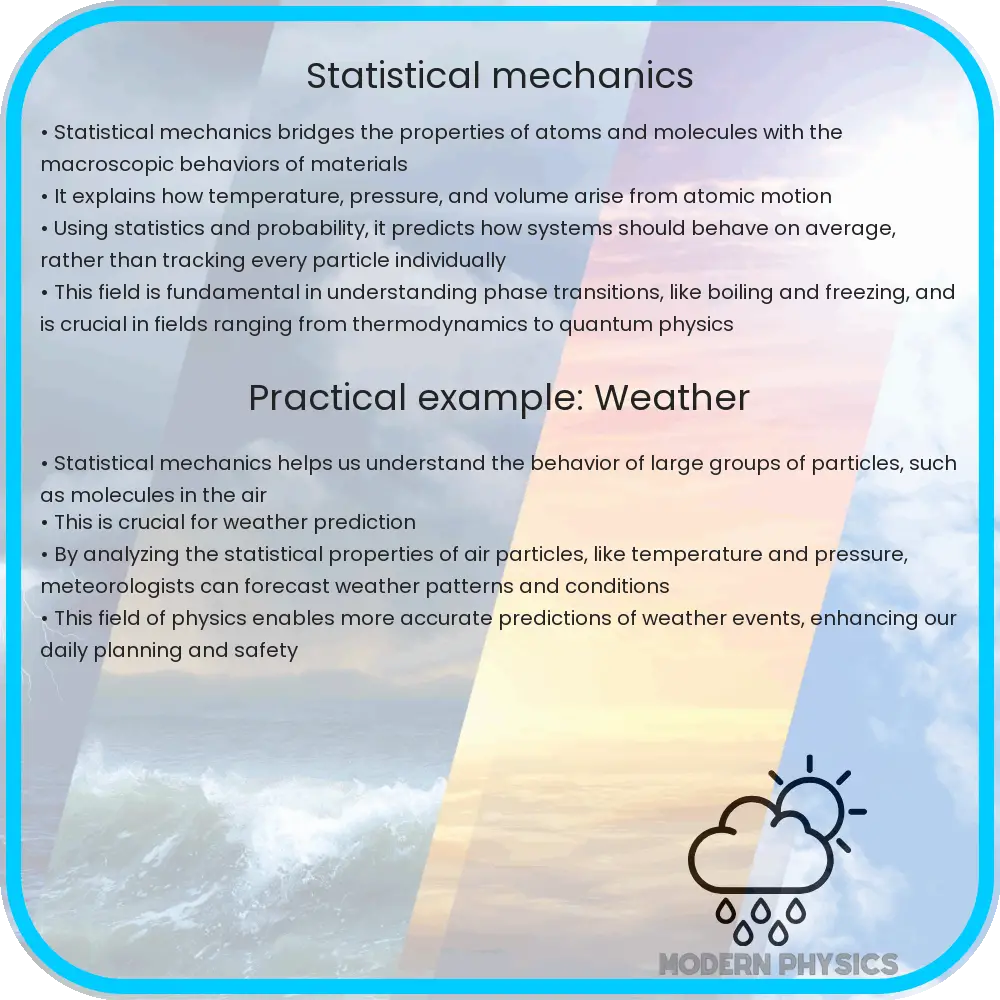Explore how statistical mechanics connects microscopic particle behavior with macroscopic phenomena in chemical physics, aiding in understanding materials and reactions.

Introduction to Statistical Mechanics: Unveiling Complexities in Chemical Physics
Statistical mechanics provides a powerful framework for understanding the microscopic origins of macroscopic phenomena. This branch of physics is pivotal in decoding the behaviors of systems composed of a vast number of particles. Its principles are particularly significant in the field of chemical physics, where the properties of materials and reactions are explicated through the statistics of atomic and molecular motion.
Foundations of Statistical Mechanics
At its core, statistical mechanics bridges the properties of individual particles with the thermodynamic characteristics of the entire system. This is achieved through ensemble theory, which encompasses a collection of microscopic states that a system can possibly attain. The premise is based on the likelihood of these states, quantitatively described by probabilities that conform to thermodynamic laws.
The central concept in statistical mechanics is the ensemble average. For instance, the canonical ensemble describes a system at constant temperature, which is a common scenario in chemical reactions. The statistical behavior of such an ensemble is characterized using the partition function, Z, defined as:
Z = Σ exp(-Ei/kBT)
Where Ei represents the energy levels of the states, kB is the Boltzmann constant, and T is the temperature. The partition function is a cornerstone in calculating macroscopic properties like entropy, pressure, and chemical potential, thus linking microscopic details with observable phenomena.
Applications of Statistical Mechanics in Chemical Physics
Statistical mechanics is indispensable in chemical physics, aiding in the study of phase transitions, reaction kinetics, and molecular dynamics among other areas:
- Phase Transitions: Statistical mechanics provides insight into the critical behavior of systems undergoing phase changes, such as from solid to liquid or liquid to gas. The theory delineates how macroscopic properties, like heat capacity and compression, alter near critical points.
- Reaction Kinetics: It helps in understanding how reactions proceed at the molecular level, particularly how temperature and molecular configurations affect reaction rates. This is crucial in designing catalysts and optimizing reaction conditions in industrial processes.
- Molecular Dynamics: By simulating the motion of molecules based on statistical mechanics, scientists are able to predict material properties, understand diffusion mechanisms, and explore protein folding processes.
The exploration of these applications demonstrates the robustness of statistical mechanics in translating complex molecular behaviors into comprehensive models that predict macroscopic properties and phenomena encountered in chemical physics.
Current Trends and Future Directions in Statistical Mechanics
Recent advancements in computational technologies have significantly propelled the field of statistical mechanics. High-performance computing and advanced algorithms enable more precise simulations and predictions. Current trends include:
- Quantum Statistical Mechanics: Delving into systems at very low temperatures where quantum mechanical effects become significant, expanding our understanding of quantum condensates and superconductivity.
- Nonequilibrium Statistical Mechanics: Exploring systems that are not in thermodynamic equilibrium, which is crucial for understanding processes in living organisms and technologically driven systems outside classical equilibrium contexts.
These trends highlight the dynamic nature of statistical mechanics and its expanding role in addressing complex scientific and engineering challenges. The continuous integration of theoretical advancements with experimental investigations promises even deeper insights into the material and biological worlds.
Educational Impact and Resource Integration
The expansive reach of statistical mechanics in educational institutions is enhancing the comprehension of complex scientific principles. Educational curriculums increasingly incorporate statistical mechanics to provide students with a robust understanding of both theoretical and applied physics. Integrative resources, including interactive simulations and virtual labs, enable students to visualize and manipulate microscopic systems, fostering a deeper understanding of the subject.
Moreover, open-access journals and online platforms have democratized the dissemination of research findings and educational materials related to statistical mechanics. This broad access aids in cultivating a global community of learners and researchers who can contribute to and benefit from the ongoing developments in this field.
Conclusion
Statistical mechanics stands as a fundamental pillar in the realm of physical sciences, bridging microscopic particle dynamics to macroscopic observable phenomena. Its principles permeate various scientific disciplines, notably chemical physics, where they elucidate material properties and reaction dynamics. The theory’s integration with advanced computational tools and educational frameworks continues to enhance its accessibility and application, making it an indispensable part of scientific inquiry and education. As computational capabilities and theoretical methods evolve, the future of statistical mechanics promises even greater advancements—extending its influence and utility across new and diverse scientific territories. This ongoing evolution will undoubtedly continue to unravel the complex behaviors of myriad systems, offering insights that could steer future technological and scientific innovations.
